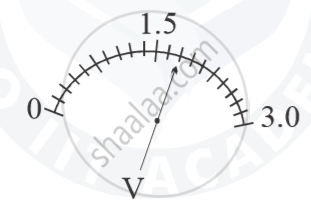Advertisements
Advertisements
प्रश्न
In a conductor 6.25 × `10^16` electrons flow from its end A to B in 2 s. Find the current flowing through the conductor (e = 1.6 × `10^-19` C)
उत्तर
Number of electrons flowing through the conductor,
N = `6.25 × 10^16` electrons
Time taken, t = 2 s
Given, e = `1.6 × 10^-19` C
Let I be the current flowing through the conductor.
Then, I = `"ne"/t`
∴ I = `((6.25 xx 10^16)(1.6 xx10^-19))/2`
= ` 5 xx 10^-3`A
Or, I = 5 mA
Thus, 5 mA current flows from B to A.
APPEARS IN
संबंधित प्रश्न
What is an Ohmic resistor?
Name the physical quantity whose unit is "ohm".
In an experiment of verification of Ohm’s law following observations are obtained.
|
Potential difference V (in volt) |
0.5 | 1.0 | 1.5 | 2.0 | 2.5 |
| current I (in ampere) | 0.2 | 0.4 | 0.6 | 0.8 | 1.0 |
Draw a V-I graph and use this graph to find:
- the potential difference V when the current I is 0.5 A,
- the current I when the potential difference V is 0.75 V,
- the resistance in a circuit.
Consider the sacle of voltmeter shown in the diagram and answer the following questions :

(a) What is the least count of the voltmeter?
(b) What is the reading shown by the voltmeter ?
(c) If the voltmeter is connected across a resistor of 20 `Omega` how much current is flowing through the resistor?
Choose the correct alternative.
Which of the following is an ohmic conductor?
State Ohm’s law? How can it be verified experimentally? Does it hold good under all conditions? Comment.
A current of 2amp flowing through a conductor produced 80 joule of heat in 10 sec. The resistance of the conductor is:-
Consider a current carrying wire (current I) in the shape of a circle. Note that as the current progresses along the wire, the direction of j (current density) changes in an exact manner, while the current I remain unaffected. The agent that is essentially responsible for is ______.
A metal rod of length 10 cm and a rectangular cross-section of 1 cm × `1/2` cm is connected to a battery across opposite faces. The resistance will be ______.
